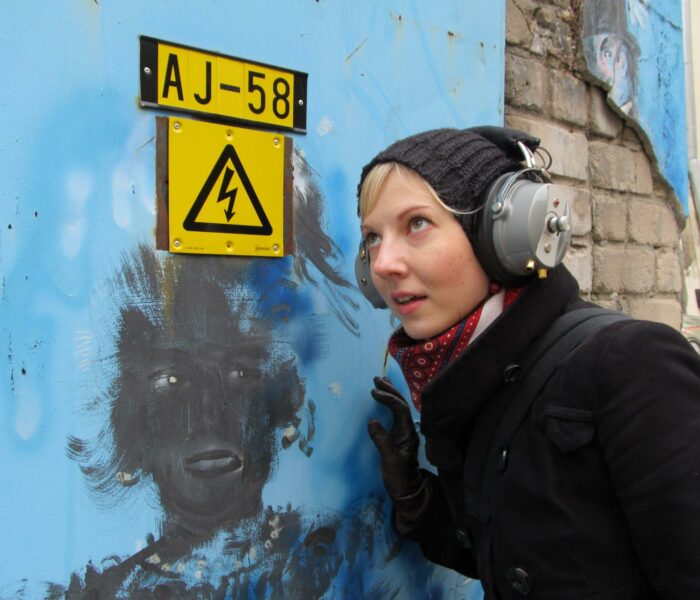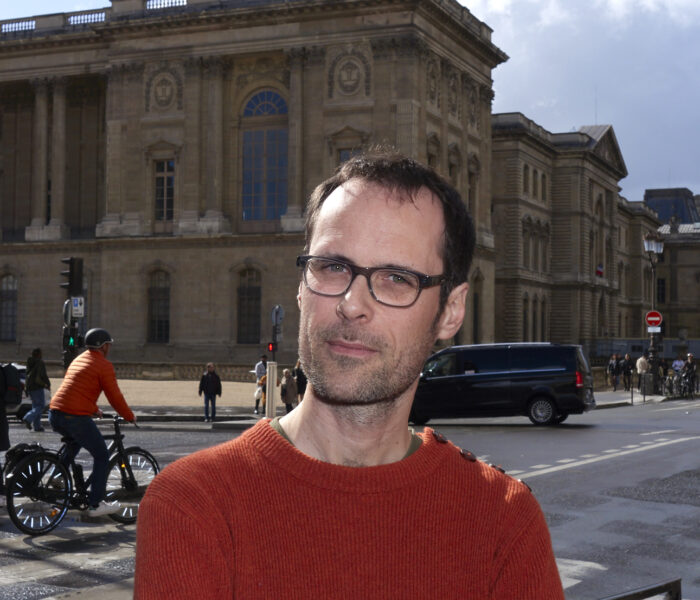Matthieu Saladin est un personnage aux multiples facettes : artiste, enseignant en arts plastiques, performeur, éditeur, auteur, il est un des représentants des musiques expérimentales depuis de longues années. Revenons sur son parcours et explorons avec lui quelques-uns des moteurs théoriques et pratiques de son travail.
« Il n’y a de son qu’en relation » Vinciane Despret
Matthieu Saladin développe une œuvre qui s’inscrit dans une approche conceptuelle de l’art, mettant en perspective, à travers la problématique du son, l’histoire des formes et des processus de création, la production des espaces, ainsi que les relations qu’entretiennent l’art et l’économie.
Fondateur de la revue Tacet, il participe aux revues Volume !, Revue & Corrigée et codirige la collection Oh cet écho.
Auteur de nombreux ouvrages, il publie son principal essai l’Esthétique de l’improvisation libre – Expérimentation musicale et politique (2014) aux Presses du réel, sur l’in situ, la création collective, l’expérimentation sonore, les relations à la liberté, à la mémoire, aux habitudes, aux règles que déjoue le processus de l’improvisation qu’il qualifie de politique.
Dans ses recherches sonores, Matthieu Saladin s’attache principalement aux expériences paradoxales du silence et de l’inaudible, ainsi qu’à ce qui se joue en matière sonore dans les conflits sociaux et les rumeurs, mettant en exergue les questions de l’écoute en commun et du partage du son que suppose toute diffusion dans l’espace public.
Ainsi, Rumeur #1 est un protocole activable où une phrase sur la qualité de l’air est chuchotée à l’oreille des visiteur·ses par le personnel de médiation d’un espace d’exposition, la phrase changeant chaque jour en fonction de la météo.
Ou encore les Sonneries publiques qui sont des énoncés textuels présentés sous la forme de sonneries téléchargeables pour téléphones portables. Le téléphone devient alors un haut-parleur diffusant des énoncés dans l’espace public.
Et parmi ces objets qui reviennent comme des moteurs théoriques et pratiques dans son travail, il y aurait quatre figures significatives : le Téléphone, le Travail, la Partition et l’Éponge, modélisant aussi bien des processus, des méthodologies théoriques que de pures créations plastiques…
1er temps : du Téléphone
Le téléphone, s’inscrivant du reste dans une grande tradition de la création sonore, est très présent dans votre travail, sous son occurrence contemporaine du smartphone. Comment vient-il à son tour s’inscrire dans votre pratique ?
Le smartphone m’intéresse beaucoup en tant qu’objet. Il représente le dispositif type de notre contemporanéité. Il est l’objet paradigmatique de nos sociétés médiatiques au sens où il cristallise un certain nombre de changements dans nos rapports sociaux et notre relation à l’espace public. Pour le dire dans les termes de Mauss, c’est tout simplement un fait social total.
Cet objet m’intéresse dès lors au regard des usages que nous en avons, de ceux qu’il a pu transformer, mais aussi pour ses caractéristiques techniques propres, aussi bien celles rendant compte d’une complexité de contrôle miniaturisée à l’extrême – les multiples capteurs et les programmes qui le constituent – qui fait de cet appareil une sorte d’« intimité connectée », que celles relevant finalement de technologies assez anciennes mais qu’il actualise, comme le fait de posséder un microphone et des haut-parleurs. Le projet Sonneries publiques utilise ainsi les haut-parleurs de nos téléphones portables qui servent notamment à diffuser les sonneries d’appel et de notification, pour essaimer des énoncés critiques dans l’espace public. Si vous installez une de ces sonneries sur votre téléphone, par exemple une phrase comme « l’espace public est un espace stratégique » ou « entre deux sonneries, le silence », cet énoncé résonnera dans, et par là même activera, le lieu où vous vous trouvez à chaque appel. À l’exception des rendez-vous téléphoniques décidés en amont, on ne choisit généralement pas quand on reçoit un appel, c’est-à-dire qu’on ne sait pas quand la phrase installée en guise de sonnerie va retentir, dans quelle situation elle va s’insérer, etc. Si cet usage reprend le principe populaire des sonneries personnalisées, il transforme également notre appareil en un dispositif de propagation à la fois critique, éventuellement ironique, et inopiné. Un autre projet, intitulé Faites comme si de rien n’était, réalisé en 2017, détournait le smartphone non plus en tant qu’émetteur de sons, mais comme récepteur de notifications textuelles. Cette pièce n’est malheureusement plus activable aujourd’hui car elle exploitait une faille du protocole bluetooth que les versions récentes des systèmes d’exploitation mobiles ont comblé. Elle consistait à diffuser de manière anonyme la phrase « Faites comme si de rien n’était » sous forme de notification à tous les téléphones portables (ayant la fonction bluetooth activée) qui croisaient le champ d’action (sur un rayon d’environ 70 m) d’une balise dissimulée en contrebas de la place de la République à Paris. Le téléphone portable est un dispositif ou un médium particulièrement approprié pour des pièces qui cherchent à se déployer dans le quotidien car c’est un objet dont la plupart des personnes ne se séparent que rarement.
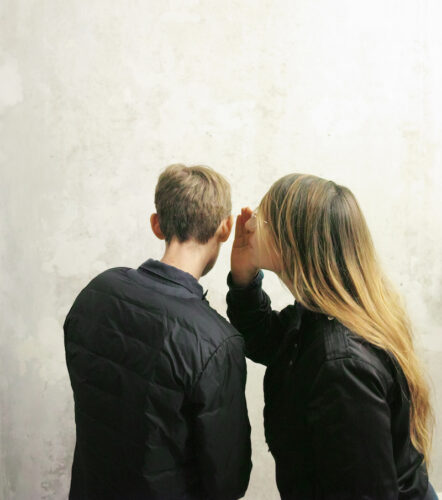


2ème temps : du Travail
La polysémie de la notion de travail est intéressante à déployer, à déplier, pour mettre en perspective toute œuvre. Comment pourriez-vous à votre tour, vous approprier cette notion ?
Plusieurs projets que j’ai menés ces derniers temps s’intéressent au travail, pour la place qu’il occupe dans nos vies, comme vecteur à la fois d’individuation et d’aliénation. Je me suis plus particulièrement concentré sur ses transformations, plus ou moins récentes, insufflées par le néolibéralisme, où tout individu devient l’entrepreneur de soi-même, comme le commente par exemple la philosophe Wendy Brown(1). J’ai ainsi commencé, il y a quelques années, une série intitulée Partitions de travail. Ces partitions ont la particularité de s’adresser non pas à des musicien·nes ou à des performer·euses, mais à des travailleur·ses. Comme le milieu où mon travail est montré est principalement le milieu de l’art contemporain, ces partitions ont été jusqu’ici interprétées par des structures d’art contemporain, par les personnes qui y travaillent. Il existe à ce jour cinq partitions, mais la série n’est pas terminée. Chacune s’intéresse à un aspect spécifique ou à un moment particulier du travail. Le Chant du dialogisme est par exemple une partition visant à interroger le rituel de l’entretien d’embauche, en le transformant en un duo entre l’employeur·se et le ou la candidat·e. Ce duo implique des parties chantées et est élaboré à partir des paroles d’une chanson connue envoyée par la personne qui postule en lieu et place de la lettre de motivation.

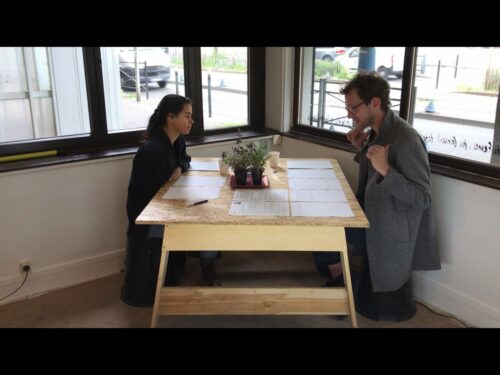
Une journée de travail propose à chaque personne travaillant dans la structure de choisir au hasard une journée de travail sur la durée de l’exposition où l’œuvre est présentée et de réaliser ce jour-là chaque action le plus lentement possible.
La partition Les parties prenantes transforme les réunions de travail en chorégraphie où s’entremêlent différents niveaux de discours, de la représentation à l’auto-perception en passant par la désignation. Une autre partition de la série consiste, quant à elle, à fixer du regard, lors de visioconférences, une source lumineuse extérieure à l’écran et à la suivre des yeux, ou encore, la dernière de la série, Scripts pour un message d’absence, intervient sur la messagerie des travailleur·ses en proposant des messages d’absence à activer durant leurs congés : dans ces réponses automatiques, des réflexions théoriques interrogeant la manière dont l’idéologie néolibérale affecte les corps s’immiscent dans des formules d’usage d’absence et produisent des énoncés singuliers, écrits à la première personne.
Plus largement, cette série découle directement de la nature contextuelle de mon travail d’artiste, au sens où je n’ai pas de pratique d’atelier, j’imagine à chaque fois les projets en fonction des situations qui les sollicitent. Et dans les structures où j’ai la chance de travailler comme artiste, il n’est malheureusement pas rare de découvrir qu’une profonde souffrance au travail y règne. Le milieu de la culture n’échappe pas à cette souffrance ; il concentre même, par certains aspects, la plupart des problèmes liés au travail dans le contexte économique et idéologique contemporain, et de manière d’autant plus pernicieuse qu’il est aussi souvent un espace de travail choisi par vocation et par passion.
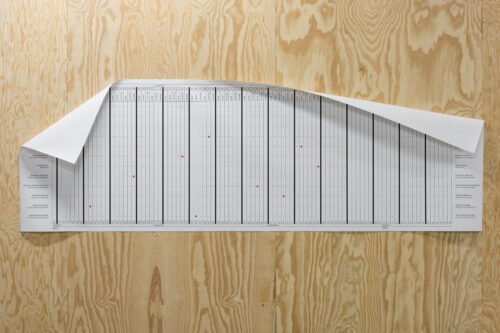
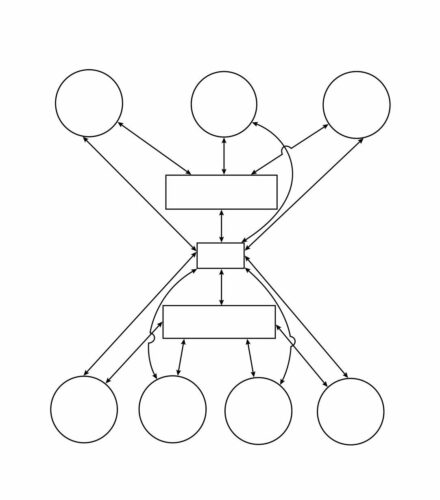
3ème temps : de la Partition
Que révèle la partition de la condition allographique de l’art, dans ses dimensions musicales, performatives, voire littéraires ?
La distinction entre œuvres autographiques et allographiques a initialement été établie par Nelson Goodman pour définir l’authenticité d’une œuvre. Les œuvres dites autographiques, comme les peintures, ne sauraient ainsi être reproduites, selon lui, sans donner lieu à une contrefaçon, alors que des œuvres dites allographiques, comme les partitions, nécessitent une exécution. Autrement dit, les œuvres allographiques se réalisent à travers leur interprétation.
Cette singularité a plusieurs implications sur le plan esthétique, mais il y en a deux qui m’intéressent particulièrement dans mon travail. La première est formulée de manière exemplaire par John Cage(2) lorsqu’il explique dans Silence que, pour lui, une œuvre n’est considérée comme complète qu’une fois qu’elle a été jouée, car seule son activation en permet l’expérience sensible. Le rapport à la performance est ici déterminant. Quand Cage dit cela, il ne réfute pas la dimension éventuellement conceptuelle de certaines de ses œuvres, mais souligne l’empirisme qui les gouverne. Le moment de la performance est essentiel car il donne lieu à une expérience où, en tant que telle, le sujet se transforme. Pour le dire à travers un concept foucaldien, la partition – dans son rapport à l’interprétation – a une fonction éthopoiétique chez Cage : elle est le vecteur d’une transformation de soi.
La deuxième implication de l’allographie lorsqu’on la pense jusqu’à son terme est l’appropriation. C’est cette fois le compositeur Cornelius Cardew qui en livre une exemplification radicale à travers son œuvre Treatise. Cette partition compte 193 pages de notation graphique pour l’interprétation desquelles Cardew n’a donné aucune nomenclature, aucune règle à suivre, sinon cette indication : « Ce que j’espère, c’est qu’en jouant cette pièce, chaque musicien·ne jouera sa propre musique – qu’iel la jouera comme sa réponse à ma musique, qui est la partition elle-même. »
Au croisement de ces deux rapports – l’appropriation et la transformation de soi – se noue quelque chose de tout à fait passionnant qui, sans être une potentialité exclusive de la forme partition dans le champ de l’expérimentation, s’y révèle de manière particulièrement saillante.
4ème temps : de l’Éponge
La notion d’éponge évoque le double mouvement d’absorption d’une matière, d’un liquide et d’un décuplement, d’un enrichissement de cette matière augmentée. Que dit cette notion de vos œuvres, de votre méthodologie de travail ?
Dans le cadre d’une exposition personnelle récente à la galerie Salle Principale, intitulée Détresse & Dividendes (septembre-novembre 2023), j’ai présenté l’activation d’un protocole qui mobilise une éponge. Si l’éponge est en effet souvent associée à l’idée d’absorption, c’est ici sa confrontation à l’assèchement de la matière qui m’intéressait. Cette œuvre consiste à déplacer l’éponge du lieu à l’origine de son activation, celle, ou l’une de celles que les personnes travaillant dans cette structure utilisent au quotidien pour diverses tâches ménagères.
Par exemple l’éponge de la cuisine, de la salle de pause ou celle des sanitaires, soit l’éponge utilisée pour les travaux de propreté et d’entretien, quel que soit son état ou son degré d’usure. Sur toute la durée de l’activation, cette éponge perd son usage ordinaire et est soumise à un assèchement, où la matière se contracte, se durcit. Elle est alors présentée comme une petite sculpture dans l’espace d’exposition.
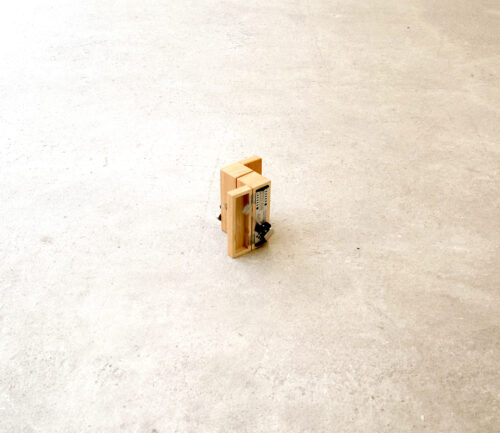
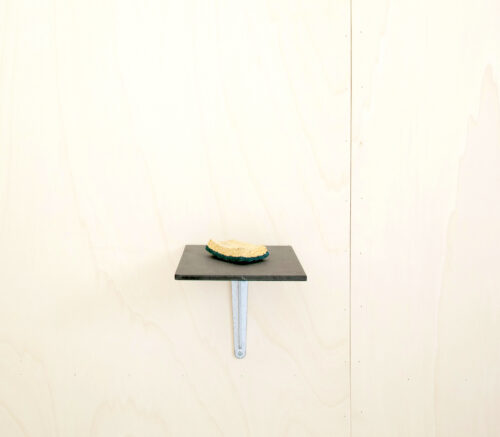
Puis, au terme de l’exposition, l’éponge retrouve sa fonction première et peut resservir. Cette œuvre a pour titre : Trying to convert a sponge into a stone (you’ll never break a window with it). C’est une phrase que j’emprunte à Cornelius Cardew, encore lui, et qu’il a écrite dans son journal en 1973, au moment où il devient maoïste, abandonnant toute pratique artistique avant-garde pour se consacrer à une musique au service du Parti communiste révolutionnaire de Grande Bretagne. En écrivant cette phrase, Cardew use d’une allégorie pour porter une critique acerbe sur les œuvres engagées, y compris les siennes, mais qui demeurent cantonnées au milieu de l’art. Dans un commentaire, John Tilbury suggère toutefois que cette critique marque également une prise de distance avec la doctrine maoïste elle-même car, selon cette dernière, une œuvre considérée comme bourgeoise peut toujours être détournée pour servir les intérêts de la révolution prolétarienne. Pour Cardew, du moins d’après ce que nous dit cette phrase mystérieuse, un tel détournement aurait tout autant ses limites. Cette phrase m’interpelle depuis longtemps ; elle a quelque chose de très poétique et en même temps d’assez cinglant dans ce qu’elle nous dit du rapport entre l’art et la politique. En tout cas, une éponge ne deviendra jamais une pierre, précisément en raison de sa capacité à la fois d’absorption et de rejet.
Propos recueillis par Pascale Cassagnau
(1)Wendy Brown, Les habits neufs de la politique mondiale. Néolibéralisme et néo-conservatisme, [Trad. Ch. Vivier, avec Ph. Mangeot & I. Saint-Saëns], Paris, Les prairies ordinaires, 2007.
(2)John Cage, Silence. Conférences et écrits [1961], [Trad. V. Barras], Genève, Héros-Limite, 2003.
(3)Michel Foucault, « L’écriture de soi » [1983], Dits et Écrits II, Paris, Quarto Gallimard, 2001, p. 1234-1249.
(4)Nelson Goodman, Langages de l’art, [Trad. J. Morizot], Nîmes, Éditions Jacqueline Chambon, 1990.
(5)Nicolas Nova, Smartphones. Une enquête anthropologique, Genève, Métis Presses, 2020.
(6)John Tilbury, Cornelius Cardew: a life unfinished, Essex, Copula, 2008.
Photo article © Emile Ouroumov.



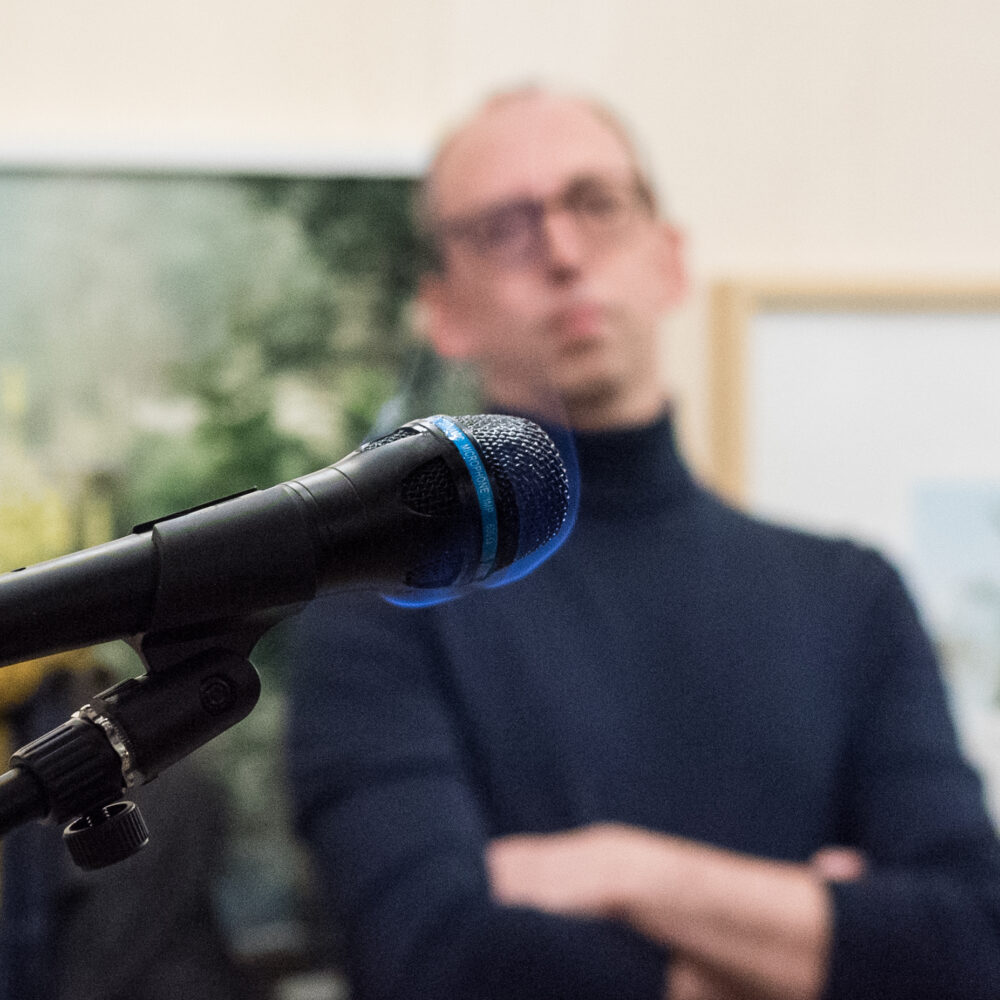)
